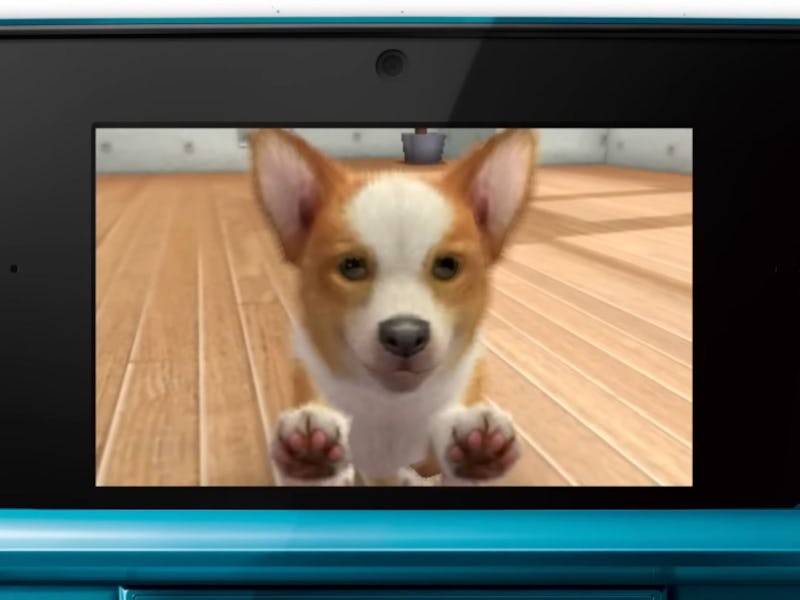We’re Still Waiting For A Game As Influential As Nintendogs 20 Years Later
Have you fed your Nintendog lately?

Everyone wants to pet the dog in video games. That desire led to the creation of a wildly popular Twitter account (back when the site was still called that and was useful for more than being called slurs), which itself made dog-petting a point of pride among developers. But way before it became a sought-after feature and a social media phenomenon, a wave of games made petting the dog the whole point of playing, and one of the best to ever do it was a perfectly named Nintendo game.
You only need to hear the title Nintendogs to know exactly what it is. Released on April 21, 2005, Nintendogs gave the Nintendo DS a virtual pet simulator and may have had more of an impact on the console’s success than it tends to get credit for.
It’s been 14 years since the last Nintendogs game graced a Nintendo console.
Nintendogs is by no means a complex game. It starts with you picking a digital dog from a kennel, taking it home, and naming it. From then on, you can teach your dog new tricks, take it for walks and enter it in obedience competitions. Like Tamagotchi and similar virtual pets before it, Nintendogs requires you to check in frequently to keep your dog washed and fed, but fortunately your new pet can never actually perish from neglect.
Even putting aside toys like Tamagotchi, Nintendogs wasn’t the first video game to center on a virtual pet. Throughout the ‘90s, developer PF.Magic release a series of virtual pet games including Catz, Dogz, and Oddballz (featuring freaky alien hybrids rather than actual animals), which let players interact with their pets on their computer desktop. I have fond memories of playing both Catz and Oddballz (I was never a dog person, sorry), but while they beat Nintendogs to the punch, they don’t come close to being as memorable as Nintendo’s take.
Nintendogs’ gameplay isn’t spectacular, but what makes it great anyway is how it uses the Nintendo DS hardware. When you first give your new furry friend a name, you do so by speaking their name into the microphone, and you also use your voice to teach them tricks. The DS touchscreen is also used to full effect, letting you pet your new pup, throw toys, and decide the route to take them on walks using the stylus.
There’s nothing complex about Nintendogs; just spending time with your virtual pet is the point.
Nintendogs even features a precursor to StreetPass, one of the best features Nintendo added to a console, which let players passively interact with each other in various games just by getting two Nintendo 3DS consoles close enough. In Nintendogs, you can enable Bark Mode, which lets your DS communicate with other consoles nearby. Using Bark Mode, you’re able to send presents into another players’ game, babysit their dogs for a while, and even trade pre-recorded voice messages. In Nintendogs + Cats, a 2011 sequel to the original Nintendogs on the 3DS, StreetPass replaces Bark Mode.
Despite its simplicity, Nintendogs uses the full range of what the Nintendo 3DS is capable of, showing why features like a microphone and touchscreen are more than just gimmicks. Most games ignored voice controls altogether, and when they were there, they never worked perfectly. But giving players a more tangible connection to their virtual dogs demonstrates that by changing how you control a video game, you can change the emotional response players have to it as well. Even more than Tamagotchi and the other virtual pets that predate it, Nintendogs lets players feel a real connection to their digital companions.
A 2011 sequel to Nintendogs adds cats to the mix.
That innovation paid off for Nintendo. According to figures from 2015, four years after the Nintendo DS was replaced by the 3DS, Nintendogs was the second-best selling game ever on the handheld, coming in behind only New Super Mario Bros. Along with other non-traditional games like Brain Age, Nintendogs helped open the Nintendo DS up to a new audience of players. At a time when games marketing was still aggressively aimed at young men, games like Nintendogs built huge audiences of women and girls, many of whom may have first discovered gaming through their virtual pets.
It may not make many lists of the best Nintendo DS games, but Nintendogs proved that video games could offer new experiences to more people by stepping outside the mold. For all its success, Nintendogs has been dormant for more than a decade, with 2011’s Nintendogs + Cats never getting a followup. The Switch 2 is already promising long-awaited revivals of series like Metroid Prime and Kirby Air Ride, but all I want is more Nintendogs.